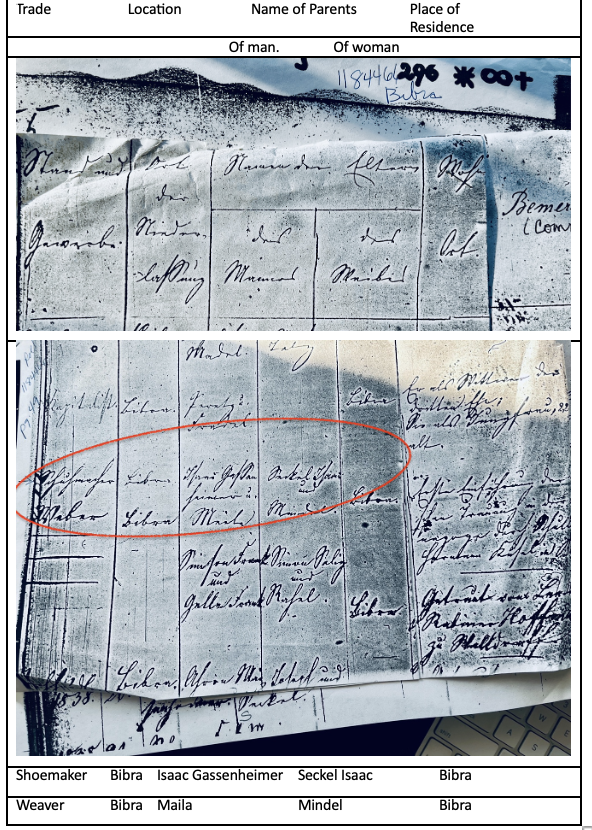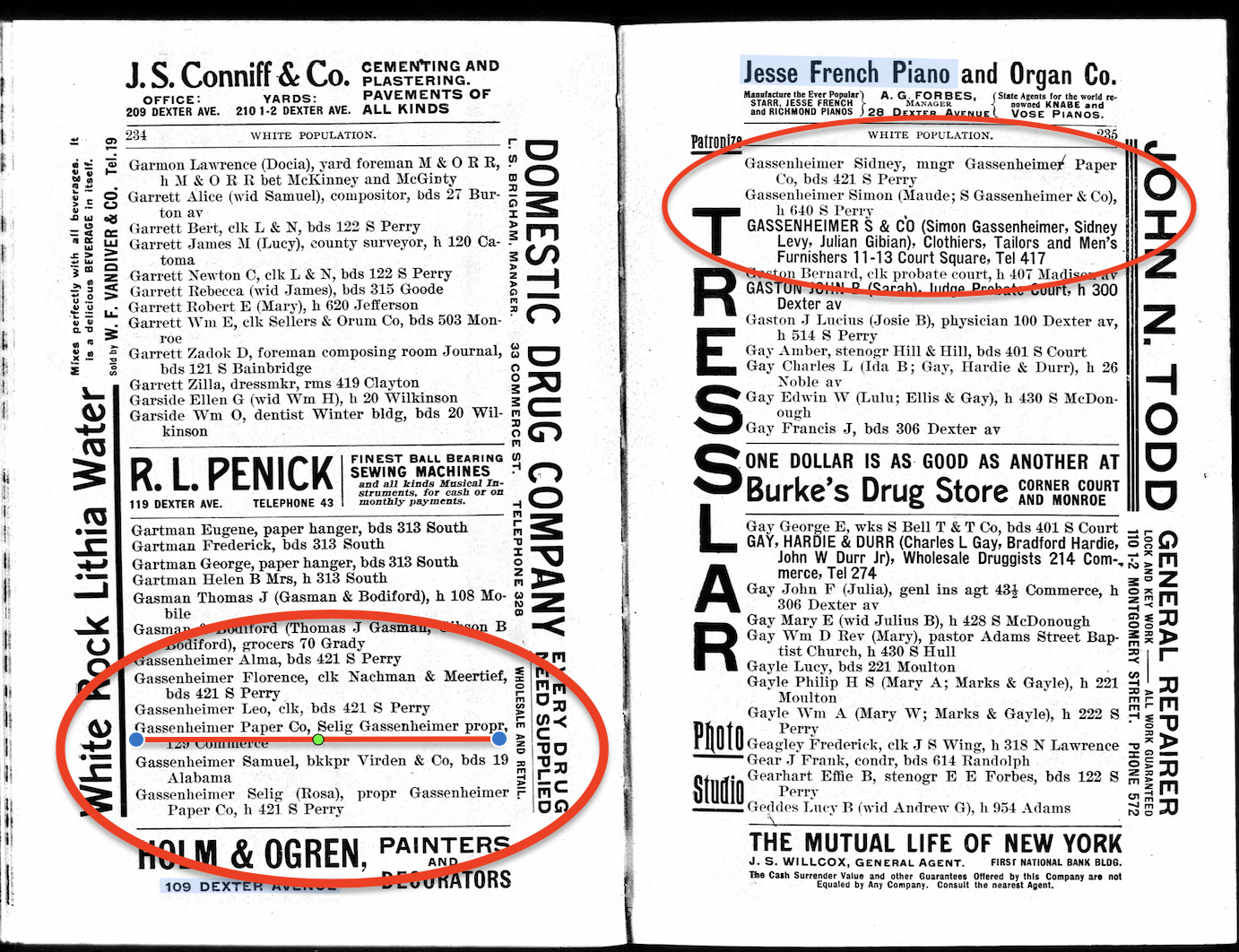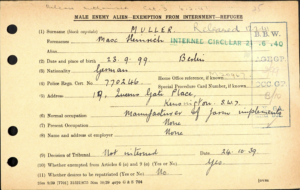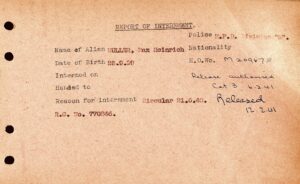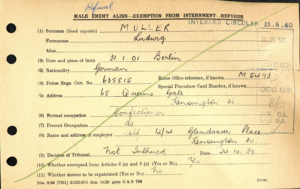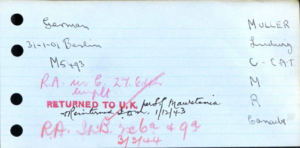See also:
The Family of Isaac & Maile Gassenheimer
Descendants List of Samuel Gassenheimer (1802-1854)
Samuel Gassenheimer was the second son of Isaac and Maile (née Gassenheimer) Gassenheimer, born 1802 in the village of Bibra.
He had two wives: the first was Blümchen Seckel, the daughter of Isaac and Mindel Seckel. She and Samuel had four children, two sons and two daughters. Blümchen died sometime around 1844, possibly with the birth of Therese, her youngest child, or sometime before 1848. Samuel subsequently married Pauline Schwab of Berkach and they had two sons: Selig Gassenheimer, b. 1849, and Simon, b. 1853.
According to this entry in the Jewish Registers, Salomon was a shoemaker and possibly a weaver.
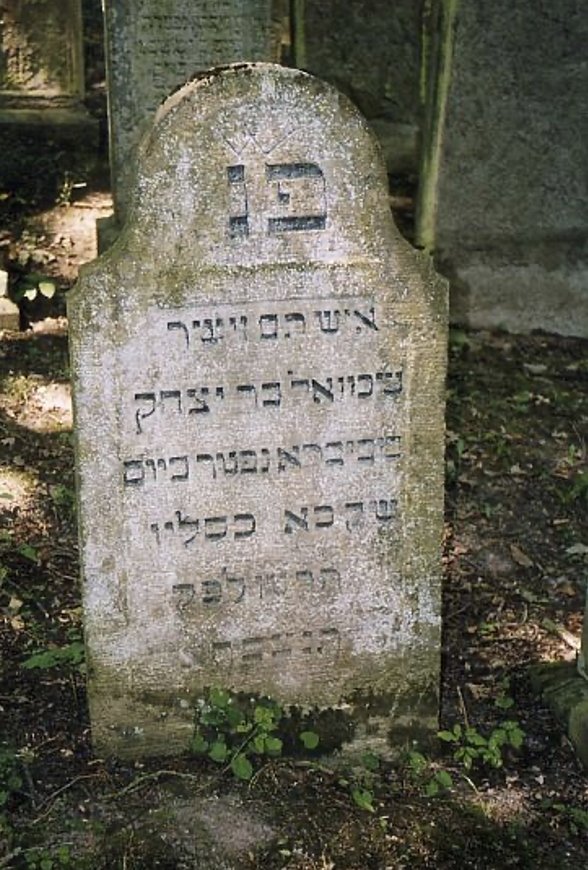
Like his father Isaac (1761-1855) and brother Joseph (1798-1876), Samuel spent his life in Bibra; age 52 in 1854, he died before his father, who lived 94-96 years, and was buried in the Bauerbach Jewish cemetery since Bibra did not have its own cemetery. The inscription says: “Here rests a perfect and righteous man: Samuel, son of Jzchak of Bibra, dying on the holy Shabbath, 21. (?) Kislew (5) 615″ (Nov./Dec. 1854).”
All of Samuel’s five children left Bibra; four left Germany altogether to seek better socio-economic opportunities the United States.
Therese remained in Germany; she married widower Louis Benari, whose first wife, Gele (Gretchen), had died in 1865. Louis had two children by his first marriage, Salomon, b. 1861, and (Therese) Rosa, b. 1862, both born in Hildburghausen. Therese and Louis moved to Coburg in Bavaria, where they had a daughter, Tekla, b. 07 March 1873. Louis Benari died less than a year after Tekla’s birth; Therese became a widow with three children under the age of 13. She continued to live in Coburg, and her 60-year-old stepmother, Pauline, moved to Coburg, where she probably helped Therese raise her family. Pauline Gassenheimer died in 1894; Therese Benari died in 1932. Both were buried in the Jewish cemetery of Coburg.
*****
The five who left for the United States emigrated after Samuel’s death; the first to go was 17-year-old Gustav (known as “Harry”), b. 1839, who left in 1856. His two stepbrothers, Selig and Simon, left in the 1860s, Selig in 1864, Simon in 1868. In 1871, Amelia Levor, née Gassenheimer, decided to emigrate: her husband, Simson Levor, had died in July 1867, and her second child, Simson, born in late October 1867 and named after his father, had died shortly after his birth. Amelia and her five-year-old son, Samuel (Simpson) Levor, arrived in the States on 26 September 1871. Joseph was the last to leave: he arrived in 1880 with his wife, Fannie (née Weisbacher) and two children.
The Gassenheimer siblings settled in various parts of the United States: Gustav “Harry” initially headed to Washington DC (perhaps because his cousin Leopold Gassenheimer was living there). In June 1861, Harry enlisted in the U.S Army; “mustered out” on 11 June 1864, he married Mina/Minnie Straus in August 1864, and they started a family with the birth of Samuel in August 1865 in Washington, DC.
Selig, the next to arrive in 1864, headed to Alabama, where there was a growing community of German Jews from the Coburg area of Bavaria; in the first years, he lived in both Montgomery and Opelika. In November 1876, he married Rosa Strauss, born in Montgomery of German parents. They started their family with birth of Sidney in 1877. Simon, the youngest of the Gassenheimers, also chose to settle in Alabama when he arrived in 1868; initially, he joined his brother in Opelika but moved on to Montgomery ten years later. On her arrival in 1871, Amelia Levor, née Gassenheimer, settled in New York with her son, Samuel. On their arrival in 1880, Joseph, his wife Fannie, and their three young children — Samuel (b. 1872), Alma (b. 1874), and Malvina (b. 1879) — also headed south.
The 1880 Federal United States Census captures a reunion of three of Samuel’s children in Opelika: Selig Gassenheimer, b. 1849, his sister Amelia, b. 1837, and Joseph, b. 1842. [What is curious about this Census data is the absence of Amelia’s son, 14-year-old Samuel (Simson) Levor, and Joseph Gassenheimer’s family.]

The same census recorded 27-year-old Simon Gassenheimer living in Montgomery, an unmarried boarder.
*****
Twenty years later, the 1900 US Federal Census locates the Gassenheimer siblings in various parts in the eastern and southeastern states: New York, New Jersey, Washington D.C., Alabama, Kentucky, and Texas.
Both Selig and Simon Gassenheimer now lived in Montgomery, Alabama. Selig and Rosa had completed their family with nine children. Simon was now married for a second time: in 1883, he had married American-born Betty Levy (b. 1861); in 1884, they had a son, named Sylvian, who only lived for a year and a half, dying in November 1885. In 1887, Betty and Simon had a daughter, Juliette. In January 1895, Betty died, age 34. Simon remarried in October 1896; his second wife was Maude Seligman; in June 1899, Simon and Maude had a daughter, Nettie Edith.
The two brothers established separate businesses: Selig owned and operated the Gassenheimer Paper company, while Simon entered into a partnership in a department store in the heart of the city. The entries in the 1902 City Directory list Selig and five of his children; Simon and his second wife Maude; plus Samuel Gassenheimer, the son of Joseph and Fannie Gassenheimer.
Montgomery, Alabama, City Directory, 1902
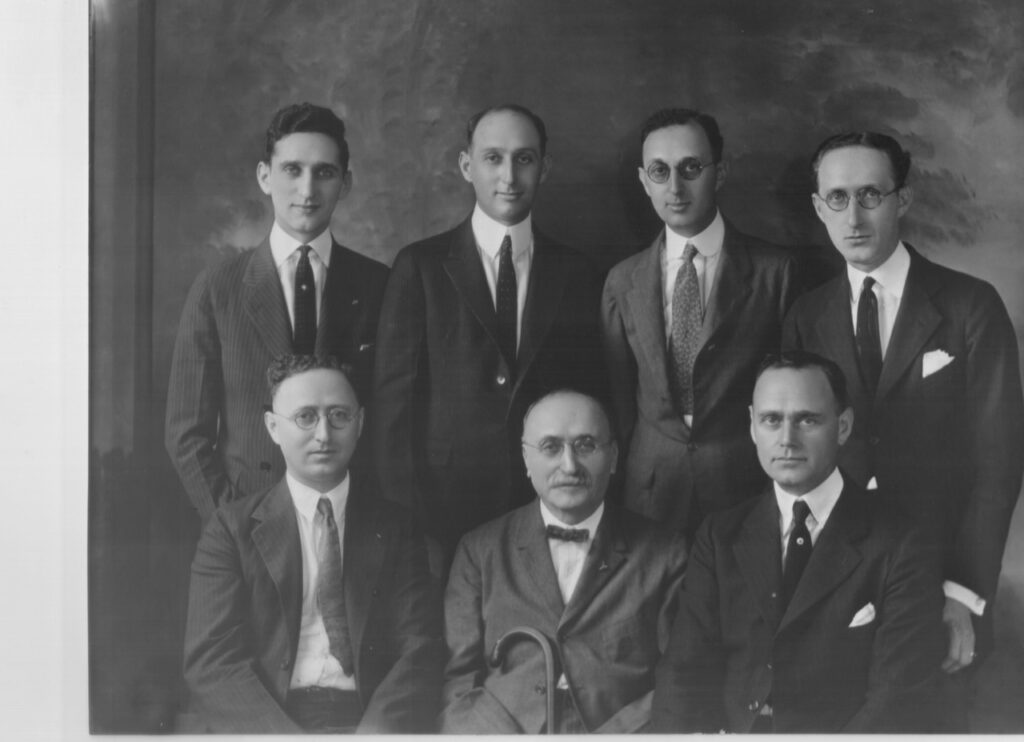
But Bibra was never forgotten, and the lives of those in America and those in Germany intersected through the years. Some Gassenheimers returned regularly to Europe — one example is Simon Gassenheimer, b. 1853 in Coburg, who travelled almost every year to Europe.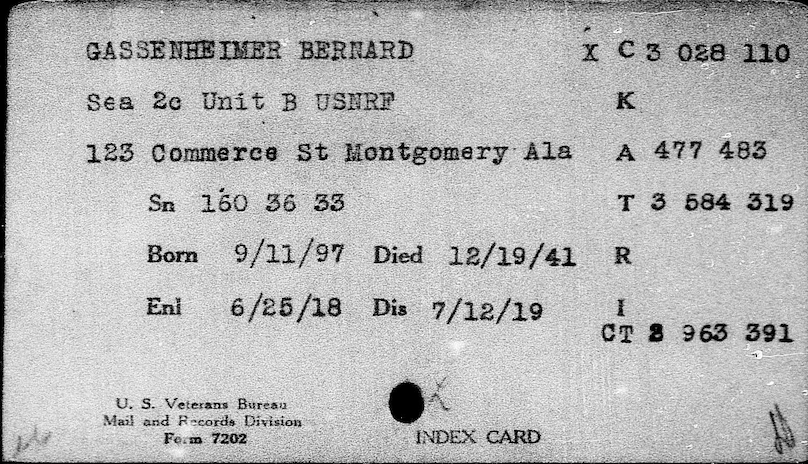
The entrance of the United States into World War I must have prompted something of a crisis for the cousins in America as they realized that their fighting in the American army might bring them face-to-face with their German Gassenheimer cousins. Several American Gassenheimers did enlist; one example is Bernard Gassenheimer, Selig’s son, who enlisted on 25 June 1918 and served until 12 July 1919. Other Gassenheimers — Albert, Armand, Edwin, Irvin, Leo, and Sidney — registered in the draft of 1917-1918 but it is not clear whether any of them fought in Germany.
*****
When the Nazi Regime began in January 1933, the family of Therese (née Gassenheimer) Benari was the only branch of Samuel’s family in Europe. Therese Benari (née Gassenheimer) had died in June 1932 in Coburg but her daughter, Tekla, and stepdaughter Rosa, were both at risk. Tekla had married Arthur Aron Müller, b. 1871 in Stuhm/West Prussia (now Sztum/Poland), and moved to live in Berlin. Two sons, Heinrich Max (b. 1899), and Ludwig Werner (b. 1901), were both born in Berlin.
Arthur Müller had been a successful entrepreneur, innovator, and manufacturer in Weimar Berlin. He had developed “new technologies and products which found a ready market in agriculture and industry. In 1912 Müller invested in air travel and founded the Luft-Verkehrs-Gesellschaft (LVG), which became the large concern AMBI-Werke. A building contractor, Muller was involved in creating Germany’s first airfield for engine-powered planes in Berlin-Johannisthal. As its operator, Müller helped to establish the site as the focal point of German aviation. Müller held the first International Aviation Exhibition (ILA) at Berlin-Johannisthal. In 1910, he commissioned the construction of a Parseval airship hangar.”1https://ber.berlin-airport.de/en/flughafenwelt/spaziergang-durch-die-luftfahrtgeschichte.html In 1926 AMBI-Budd began to produce car-bodies.2https://www.nli.org.il/en/books/NNL_ALEPH990020666560205171/NLIArthur and Tekla travelled on business to the United States and their son Max lived there for several years.
The Nazi Regime ended Arthur Müller’s successful career and in 1935, he died. While both Max and Ludwig were able to acquire temporary permits to enter England, Tekla was forced to remain in Berlin to wind up the business affairs of her late husband.
In May 1939, both Max and Ludwig were in London, both living at the same address, 65 Queen’s Gate in Kensington. Max was a widower, having lost his wife, Elisabeth Susanne (née Askenasy) to cancer in 1934, and Ludwig was divorced.

Declaration of war in September 1939 made both Max and Ludwig “enemy aliens.” At their meetings with Enemy Alien tribunals, they were both declared “exempt from internment.” However, following the German conquest of France in June 1940, both brothers were rounded up. Max was interned within Great Britain and released on 21 February 1941.
Ludwig, however, was deported to Canada and interned there until December 1943, when he returned to England.
At the 11th hour of possible escape from the Nazi tyranny, Tekla Müller, completely impoverished, was able to leave Germany in June 1941; she brought the ashes of her dead husband with her.
On 23 March 1946, Tekla Müller welcomed her son Max upon his arrival in New York; shortly after his arrival, Max married Helene Blauzwirn, whom he had met while in Great Britain. In England, Ludwig also remarried in October 1948; his wife was Francis Mary Machin. Tekla died in 1953; Max in 1983, and Ludwig in 1989. Neither Max nor Ludwig appear to have had any children.
*****
The story of the family of Rosa Benari, the stepdaughter of Therese Benari, née Gassenheimer, is sketchy, based on records available in the Joods memorial site, the Arolsen Archives, Geni.com profiles and other internet sources. In 1887, Rosa married artist Benjamin Liepman Prins and moved to Amsterdam. They had two daughters, Gretha, b. 1888, and Alice (known as Molly), b. 1896. Both women married and formed families: Gretha married a rabbi, and they had two daughters and one son. Molly married Julius Jacob Keizer and they had a son, Jules Albert, born in 1919.
In December 1938, the year when it was clear that the Nazis were determined to remove Jews from any country they occupied, there were at least eight members of the Prins family living in Holland. Rosa Prins died on 28 December 1938, four years after the death of her husband. Gretha Prins’s husband, rabbi Adolph Elias, had died in 1928. But Gretha and all three of her children were alive in 1938 and, at the end of the war. Gretha’s eldest daughter, Hettij, obtained entry into England with her husband Stefan Fried and remained there until her death in 1987. How Gretha and daughter Anna and son Erik managed after the German conquest of Holland in 1940 is still to be discovered. Gretha Elias died on 10 December 1981 in Eindoven, Holland.
Molly’s story ended in Auschwitz. Julius Keizer died on 21 October 1940 in Apeldoorn, Holland, age 60. On 24 June 1942, Molly married Salomon Dukker, a widower since 1937. On 26 May 1943, Salomon was interned in the Westerbork Transit Camp and on 01 June 1943, he was deported to the Sobibor killing centre and murdered upon arrival on 04 June 1943. Alice ‘Molly’ was deported from Westerbork to Auschwitz on 03 March 1944; she was murdered soon after her arrival in the killing centre.
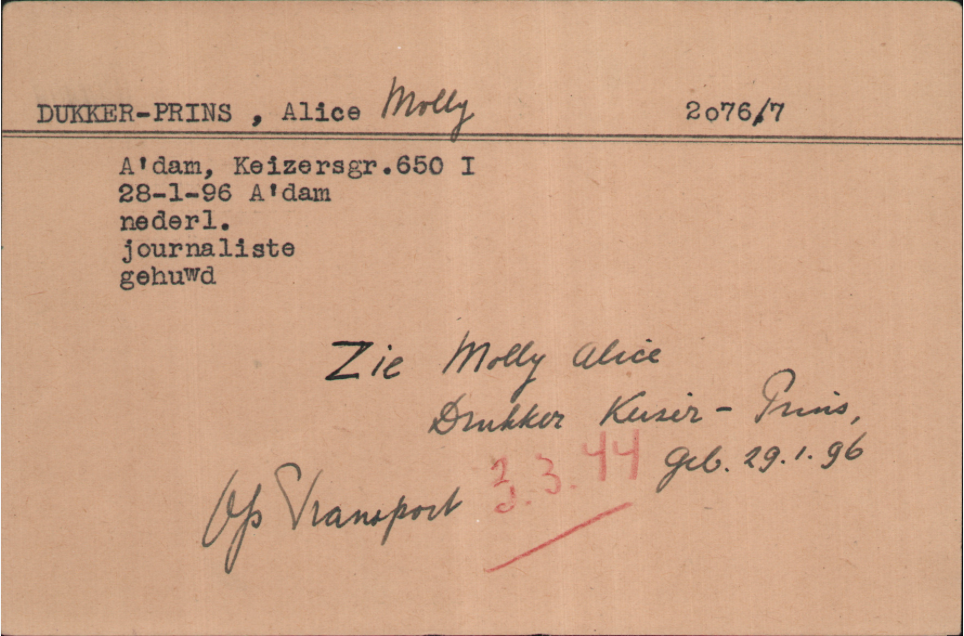
*****
Whether there was contact between the Gassenheimer families living in the United States and the Benari/Müller/Prins families in Berlin, England, and Holland is probably something we will never know.
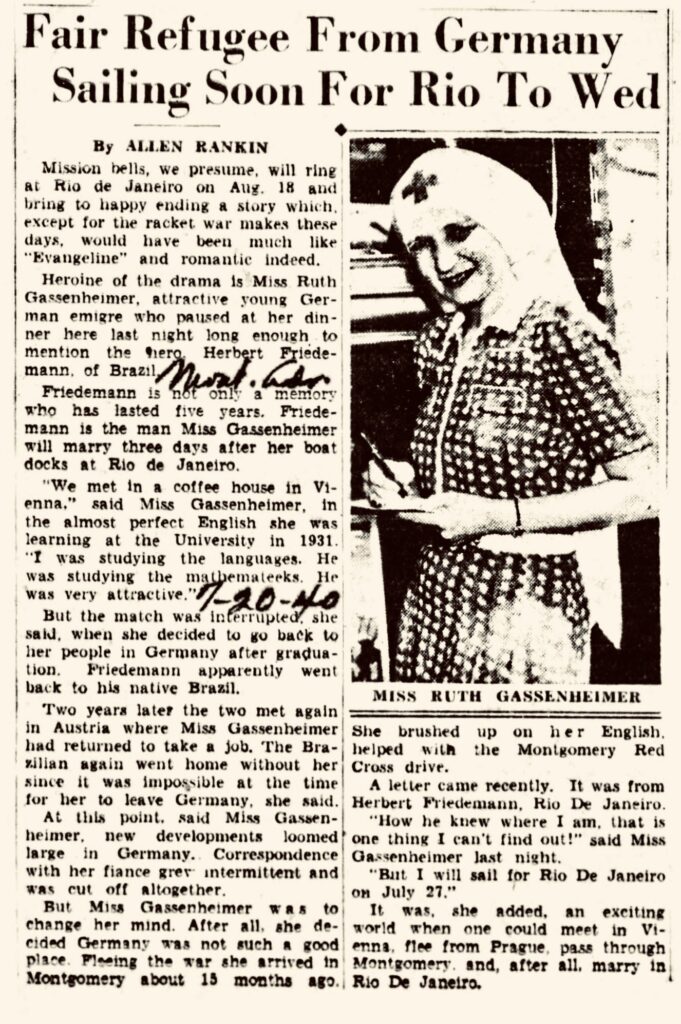
We do, however, know one story of an American Gassenheimer rescuing a German cousin. In April 1939, Leo Gassenheimer (b. 1885 in Montgomery, Alabama) sponsored Ruth Gassenheimer’s entry into the United States. Ruth, b. 1904 in Halle/Saale, Saxony, was the daughter of Georg Gassenheimer (b. 1874 in Themar), son of Samuel and Lotte (née Stein) Gassenheimer, and Selma (née Schwab) Gassenheimer. Somehow, Georg had made contact with his younger cousin Leo and he and his family had responded. Ruth stayed for over a year in Montgomery living with Leo’s sisters, Florence Moog (née Gassenheimer) and Alma Schlesinger (née Gassenheimer), but her final destination was Rio de Janeiro where she planned to marry Herbert Josef Friedmann, a man she had met when both were studying at the University of Vienna. In July 1940, Ruth left the United States, sailing from New Orleans to Rio de Jainero. On 19 September 1940, she and Herbert married.
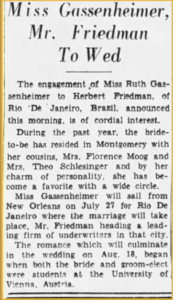
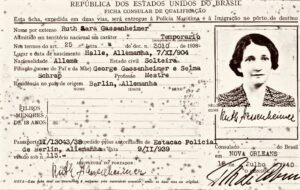
Sources:
Arolsen Archives

